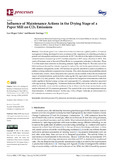Mostrar el registro sencillo del ítem
Influence of maintenance actions in the drying stage of a paper mill on CO2 emissions
| dc.creator | Calvo Herrero, Luis | es_ES |
| dc.creator | Domingo, Rosario | es_ES |
| dc.date.accessioned | 2022-04-07T12:10:23Z | |
| dc.date.available | 2022-04-07T12:10:23Z | |
| dc.date.issued | 2021 | |
| dc.identifier.issn | 2227-9717 | |
| dc.identifier.uri | https://hdl.handle.net/2454/42695 | |
| dc.description.abstract | Greenhouse gases from industrial activities have become a global problem. Emissions management is being developed to raise awareness of the importance of controlling pollution in general and atmospheric emissions in particular. In 2017, the deficit of the rights of issuance in the industrial sectors increased up to 8.3% (verified emissions in 2017 versus allocation in 2017). This trend will increase more at the end of Phase III due to a progressive reduction in allocation. Phase IV will be much more restrictive in allocating emission rights than Phase III. The extra cost of this deficit reinforces the need for industry in general to reduce CO2 and for the paper industry to reduce GHG emissions and generate credits. Old factories are typically identified as sources of pollution in addition to being inefficient compared to new factories. This article discusses the possibilities of-fered by maintenance actions, whose integration into a process can successfully reduce the environmental impact of industrial plants, particularly by reducing the CO2 equivalent emissions (CO2-eq units henceforth CO2) they produce. This case study analyzes the integration of maintenance rules that enable significant thermal energy savings and consequently CO2 emissions reduction associ-ated with papermaking. Managing Key Performance Indicators (KPIs), such as the amount of cold water added to the boiler circuit and the conditions of the air blown into the dryer section hood, can be used as indicators of CO2 emissions generated. The control of the water and temperature reduces these emissions. A defined measure—in this case, t CO2/t Paper—indicates an achievement of a 21% reduction in emissions over the past 8 years. | en |
| dc.description.sponsorship | The authors thank the Spanish Ministry of Science, Innovation and Universities for supporting through RTI2018-102215-B-I00 project. | en |
| dc.format.extent | 20 p. | |
| dc.format.mimetype | application/pdf | en |
| dc.language.iso | eng | en |
| dc.publisher | MDPI | |
| dc.relation.ispartof | Processes, 9 (10), 2021 | |
| dc.rights | © 2021 by the authors. Creative Commons Attribution 4.0 International | en |
| dc.rights.uri | http://creativecommons.org/licenses/by/4.0/ | |
| dc.subject | CO2 emissions | en |
| dc.subject | Industrial process | en |
| dc.subject | Maintenance | en |
| dc.subject | Papermaking | en |
| dc.title | Influence of maintenance actions in the drying stage of a paper mill on CO2 emissions | en |
| dc.type | Artículo / Artikulua | es |
| dc.type | info:eu-repo/semantics/article | en |
| dc.contributor.department | Ingeniería Mecánica, Energética y de Materiales | es_ES |
| dc.contributor.department | Mekanika, Energetika eta Materialen Ingeniaritza | eu |
| dc.rights.accessRights | info:eu-repo/semantics/openAccess | en |
| dc.rights.accessRights | Acceso abierto / Sarbide irekia | es |
| dc.identifier.doi | 10.3390/pr9101707 | |
| dc.relation.projectID | info:eu-repo/grantAgreement/AEI/Plan Estatal de Investigación Científica y Técnica y de Innovación 2017-2020/RTI2018-102215-B-I00/ES/ | en |
| dc.relation.publisherversion | https://doi.org/10.3390/pr9101707 | |
| dc.type.version | info:eu-repo/semantics/publishedVersion | en |
| dc.type.version | Versión publicada / Argitaratu den bertsioa | es |



